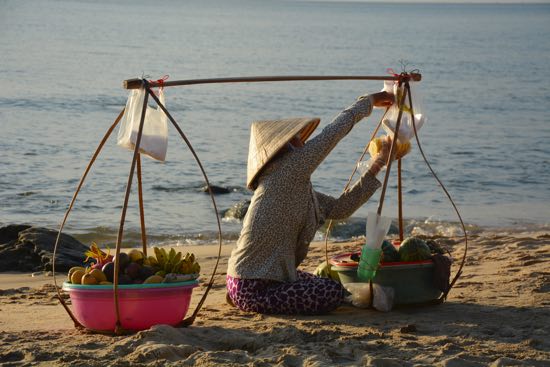Mekong Delta
Once a hostile swampland, the French drained this region, transforming it into lucrative plantations, paddy fields and mines. Most of the chemical herbicides sprayed during the Vietnam War fell over the Mekong Delta, denying the Viet Cong cover and in the process decimating agricultural lands and mangrove forests. Yet today, the Mekong Delta is Vietnam’s most productive agricultural area, producing nearly half of the nation’s annual food crop. Tours Indochina Vietnam
Nutrient-rich deposits carried by the Mekong River and its comprehensive network of waterways and nine tributaries (hence the local name, ‘River of Nine Dragons’) makes this region extraordinarily fertile for rice, bananas, coconuts, tropical fruit and sugar cane. It’s this very luscious, intensively cultivated landscape and rustic way of life that make this area so picturesque and appealing. Secluded waterways with overhanging foliage lined with stilt houses, mangrove swamps, paddy fields, fruit orchards and welcoming locals make up much of the scenario.
Independent travel can be frustrating – transport is basic, time-consuming and water-based – so for less hassle, inclusive tours are the best way to experience this area. Many tours incorporate visits by small boats to fruit orchards, cottage industries, Khmer temples, early-morning floating markets, or penetrate deep into a labyrinth of narrow waterways. Increasingly, some incorporate bicycle trips, home stays or one-way boat tours terminating in Phnom Penh (Cambodia). South Vietnam travel packages

Places to visit on the Mekong
My Tho y is the first stop out of HCMC; done to death by tourism over the years, westward hubs like Vinh Long, Ben Tre, Cai Be and Can Tho afford more authentic experiences, less rushed in multi-day tours. Further west, Chau Doc offers Khmer ethnic communities, floating fish farms and Sam Mountain, with sacred pagodas and sweeping views. Across the Cambodian border, Ca Mau National Park and Tram Chim National Park are important havens for water birds. The more remote west coast is far less touristy, with the sleepy fishing port of Ha Tien, plus Rach Gia, the launch pad for Phu Quoc Island, 62 nautical miles west.
Phu Quoc Island
Sitting in the Gulf of Thailand, the island of Phu Quoc is about the same size as Singapore and is the largest of all the Vietnamese islands. The island offers visitors a mix of mountains, lush forest covered hills, waterfalls, bubbling streams and some of Vietnam’s best beaches. It is also one of the few places in Vietnam that you can enjoy the sun setting over the sea.
Phu Quoc Island has long had the natural ingredients that one expects from a beach holiday but now it has the hotels to match.
Long Beach is the star and it is bearing the brunt of the boom. In the dry season, the 20-plus kilometre stretch of yellow sand that runs from Duong Dong town down the central west coast of the island is the liveliest beach of the island, the entire length offering beachfront accommodation and places to play, laze and dig into seafood while digging your feet in the sand. Being one of the few beach destinations in Vietnam with a western coast, at the end of the day everyone gathers here to worship the memorable sunset.
If beach bustle isn’t your scene, it’s possible to find that wild, unspoilt feeling that first drew travellers here. Phu Quoc’s freshly paved arterial roads coupled with dramatic scenery make it a fantastic place to explore by motorbike. Ong Lang, Bai Vung and Bai Sao are just a few of the beaches you should consider staying at or at least visit. Anyone with a window seat on the plane will be struck by how staggeringly green the island is. More than half of it is national park and in 2006 the island was included in the UNESCO designation of Kien Giang as a World Biosphere Reserve. The north and east coast remains relatively untouched by tourism. If you want to experience what the island was like just 10 years ago, head out on the dirt roads that will take you past lush jungle and the island’s many famed pepper plantations.
Không có nhận xét nào:
Đăng nhận xét